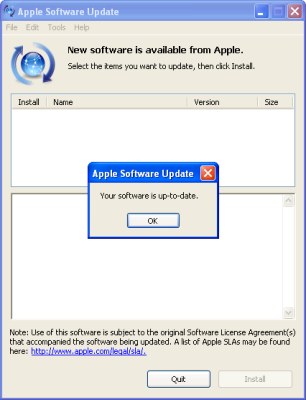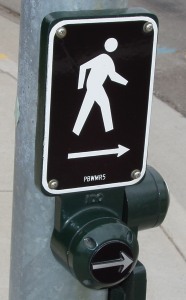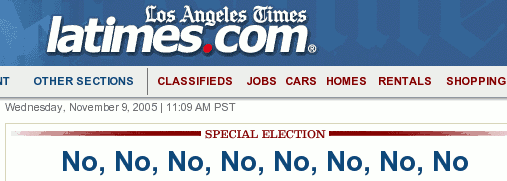Take a look at this press release for the Los Angeles Science Fiction and Comic Book Convention and see if you can figure out what’s missing: Continue reading
Tag: usability
ATM Design: Take Your Card
Clever UI design on ATM: with fast cash, it won’t give you the cash until after you take your card. Usually I grab it fast, so I never noticed.
No, They Don’t Read
It’s clear that a lot of people don’t actually read web pages before they respond to them. They’ll do things like…
- Contact someone with a similar name, even when it’s clearly the wrong sort of organization — say, a student writing club and not the bookseller that’s been causing them problems.
- Ask a blogger for a job application for a company mentioned in the post.
- Ask unrelated tech support questions on a blog post because they used the wrong search terms for their problem.
- Ask for help creating Flash animations on a forum dedicated to the Flash super-hero, then get indignant when people have the gall to point out that they’re in the wrong place.
Now, usability guru Jakob Nielsen reports on a study showing just how much people don’t read. In the average visit, users only read 28% of your text if you’re lucky. You have to drop way down — to 111 words — just to count on visitors reading half of it.
Depressing, but it explains so much. And it suggests there’s a benefit to highlighting key phrases. If they’re only going to read ¼ of the text, you may as well make sure it includes the important stuff.
Apple UI Nitpicking
I appreciate that Apple offers a single software updater for all its free Windows software. But one thing annoys me about it.
It opens a window, then opens a message box showing a progress meter as it checks for updates. Only one problem: It fills out the “New software is available” caption before it actually checks.

New software is available… oh, wait, no it isn’t.
This isn’t an issue on Mac OS X, because the progress meter is shown as a sheet, which drops down from the top of the main window and obscures the caption. But on Windows, that caption is visible from the moment the window appears, saying that you really do have something new available, raising your hopes that maybe, just maybe, Apple has finally gotten around to releasing that new version of Safari, or that security fix for the flaw you heard about a week ago, then dashing them to the ground.
Or, less dramatically, it’s jumping to conclusions, providing potentially false information.
And then, even if it turns out there isn’t anything new, the caption stays in place…leaving you with two contradictory statements as to whether any updates are really available.
Just can’t win
This is a story on phone menus, though it applies to anything where the user interface can change. I phoned in a refill on a prescription this morning. The phone system lets you choose when you plan on picking it up, presumably so that the pharmacy can prioritize people who are coming in sooner. Generally, it asks you to enter the hour, then #, then 1 for AM or 2 for PM.
I wanted to swing by around noon, so I entered 12, then #, and then without listening for the option, I hit 2. I wanted to pick it up around 12:00 pm.
So I was surprised to hear, “We’re sorry, the pharmacy is not open at midnight.” I flashed back to elementary school, when I was out on the field trying to explain to my friends why noon was 12 PM and not 12 AM as they insisted. Had someone managed to get into a programming position, without clearing that up?
As I re-entered the time, I listened for the options. It turns out that they had anticipated just such confusion, as after I chose 12, the option was, “Please enter 1 for noon, or 2 for midnight.” That works great for people who are using the system for the first time, whether they know noon is PM or not. Unfortunately, for people who have been using it for years and (normally) don’t need to listen to the options, it switches the buttons around. It’s like those WinZip registration dialog boxes that would rearrange the buttons every time, so that you couldn’t just click through, you’d have to pay at least some attention to it.
Of course, then there’s the question of why it even gives you the option for midnight…
Building a Better Walk Signal
 I recently took a walk through some streets that have only recently opened to traffic. One of the things that struck me was that the buttons for triggering the walk/don’t walk signs had a new design. Instead of a tiny recessed button, or a larger rounded button, they had a ~2″ flat button with a raised arrow.
I recently took a walk through some streets that have only recently opened to traffic. One of the things that struck me was that the buttons for triggering the walk/don’t walk signs had a new design. Instead of a tiny recessed button, or a larger rounded button, they had a ~2″ flat button with a raised arrow.
My first thought was, why the extra arrow? It’s pointing in the same direction as the sign. And it means you have to press the button carefully instead of just whacking it with your hand. The answer hit me later in the walk. I was leaning on the button with my hand when the light changed, I and felt the button vibrating. Of course! It was for blind pedestrians!
The raised arrow makes it easier to hit the right button, rather than just hope that the buttons have been placed in standard orientation. And vibrating the button makes it clear not only that it’s safe to cross, but in which direction it’s safe to cross. That’s one thing I could never figure out about the chirping walk signs in San Diego. It tells you the light’s changed, but if there’s any indication as to which light is green, I’ve never noticed it.
Uh, that’s a negative
The Los Angeles Times website had an interesting way of describing the results of yesterday’s state election:
It’s hard to believe that all eight propositions failed. Even the four Orange County measures failed. Every item on the ballot in our district was rejected!
On a related note, I still don’t like the voting machines we have in OC. The interface is cumbersome and the display is godawful slow. The controls consist of a dial, which moves the cursor, and a button, which selects the current item.
The display is so slow you can watch it redrawing the title and summary of a ballot item when it highlights it. First the rectangle turns blue, then it redraws the text, line by line, in white. It’s like watching print preview in Word Perfect 5.1 for DOS on a 386. You just don’t see that kind of performance on modern computers unless they’re massively bogged down.
As for trying to use the machine, it’s kind of like entering your name in the high score list on an arcade video game with only a trackball and a fire button. I’m sure they chose it for durability reasons—a touch screen would be much more usable, but much easier to break—and went with the low-powered processor to keep the costs down.
I actually liked the punchcards we had before. It was so much more satisfying to slam down that lever.
